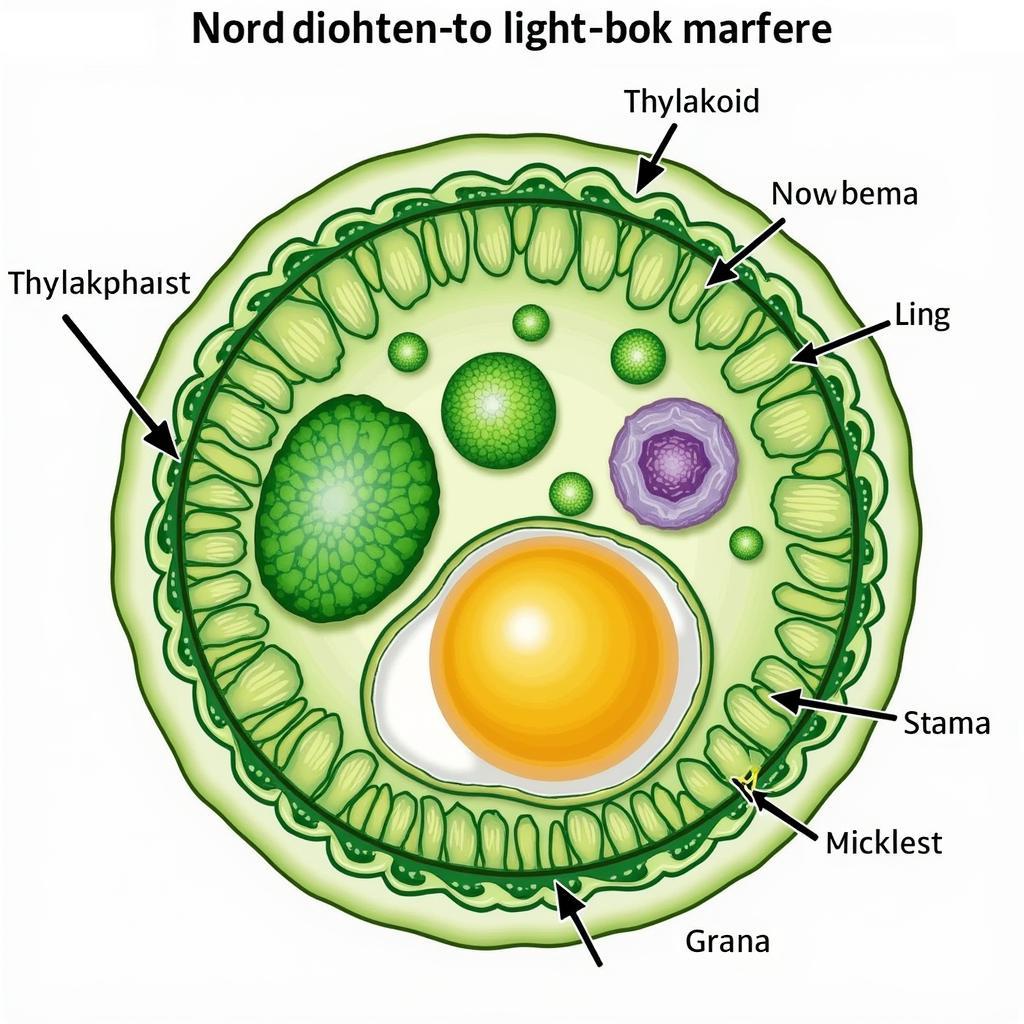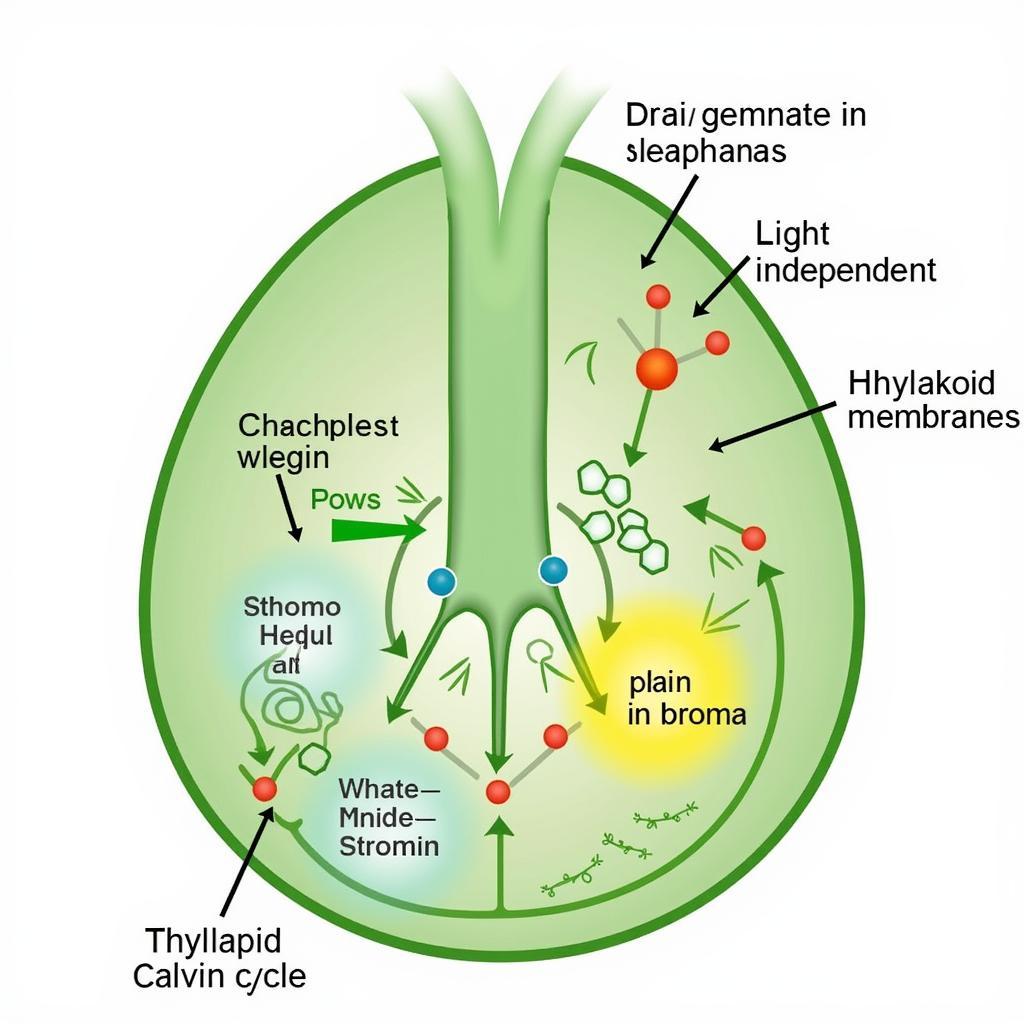The light-dependent reaction, a crucial part of photosynthesis, takes place in the thylakoid membranes within chloroplasts. Understanding this process is key to grasping how plants convert light energy into chemical energy, ultimately fueling life on Earth. This article will delve into the specifics of this fascinating biological mechanism, exploring the location, process, and significance of the light-dependent reaction.
Inside the Chloroplast: The Home of the Light-Dependent Reaction
The light-dependent reaction occurs within the thylakoid membranes, which are internal membrane systems found within chloroplasts. Chloroplasts are specialized organelles found in plant and algal cells, responsible for photosynthesis. Think of the chloroplast as a miniature factory, and the thylakoids as specialized departments within that factory. These thylakoid membranes are organized into stacks called grana, increasing the surface area available for the light-dependent reactions to occur. This increased surface area maximizes light absorption and therefore the efficiency of photosynthesis.
 Thylakoid Membrane Structure and Light-Dependent Reaction
Thylakoid Membrane Structure and Light-Dependent Reaction
The Light-Dependent Reaction: A Step-by-Step Process
The light-dependent reaction is a complex process involving several key steps:
Light Absorption: Chlorophyll and other pigments embedded within the thylakoid membrane absorb light energy. This captured energy excites electrons within the chlorophyll molecules.
Electron Transport Chain: The excited electrons are passed along a series of protein complexes within the thylakoid membrane, known as the electron transport chain. This movement of electrons releases energy, which is used to pump protons (H+) from the stroma (the fluid surrounding the thylakoids) into the thylakoid lumen (the space inside the thylakoid).
ATP Synthesis: The build-up of protons within the thylakoid lumen creates a proton gradient across the thylakoid membrane. This gradient drives the flow of protons back into the stroma through an enzyme called ATP synthase. This flow of protons powers the synthesis of ATP (adenosine triphosphate), the energy currency of the cell.
Water Splitting (Photolysis): Water molecules are split to replace the electrons lost by chlorophyll. This process releases oxygen as a byproduct, which is the source of the oxygen we breathe.
NADPH Formation: Electrons from the electron transport chain are ultimately transferred to NADP+ (nicotinamide adenine dinucleotide phosphate), reducing it to NADPH. NADPH carries high-energy electrons and is used in the subsequent light-independent reactions (Calvin cycle).
The Importance of the Light-Dependent Reaction
The light-dependent reaction plays a vital role in converting light energy into chemical energy in the form of ATP and NADPH. These energy-rich molecules are essential for the next stage of photosynthesis, the light-independent reactions, where carbon dioxide is fixed into glucose. Without the light-dependent reaction, plants would be unable to produce the sugars they need for growth and survival.
“The thylakoid membrane is a remarkable structure. Its highly organized arrangement of proteins and pigments optimizes the capture and conversion of light energy, ultimately driving the entire photosynthetic process,” says Dr. Amelia Green, a leading plant biologist.
Why Location Matters in Photosynthesis
The location of the light-dependent reaction within the thylakoid membrane is crucial for its efficiency. The membrane provides a framework for the organization of chlorophyll and other pigments, maximizing light absorption. The membrane also separates the thylakoid lumen from the stroma, allowing for the establishment of the proton gradient that drives ATP synthesis.
 Photosynthesis in the Chloroplast
Photosynthesis in the Chloroplast
Conclusion
The light-dependent reaction, taking place in the thylakoid membranes within chloroplasts, is the engine that powers photosynthesis. By capturing light energy and converting it into chemical energy, this critical process sustains plant life and ultimately provides the oxygen and food that support life on Earth.
FAQ
- What are the products of the light-dependent reaction? ATP, NADPH, and oxygen.
- What is the role of chlorophyll in the light-dependent reaction? Chlorophyll absorbs light energy, initiating the photosynthetic process.
- Where do the light-independent reactions occur? In the stroma of the chloroplasts.
- What is the main purpose of photosynthesis? To convert light energy into chemical energy in the form of glucose.
- What is the difference between the light-dependent and light-independent reactions? The light-dependent reactions require light and produce ATP and NADPH, while the light-independent reactions use ATP and NADPH to fix carbon dioxide into glucose.
- Why is the thylakoid membrane important for the light-dependent reaction? It houses the pigments and proteins necessary for light absorption and electron transport.
- What is photolysis? The splitting of water molecules to release electrons, protons, and oxygen.
Need assistance? Contact us at Phone Number: 0372960696, Email: TRAVELCAR[email protected] Or visit us at: 260 Cầu Giấy, Hà Nội. We have a 24/7 customer service team.

